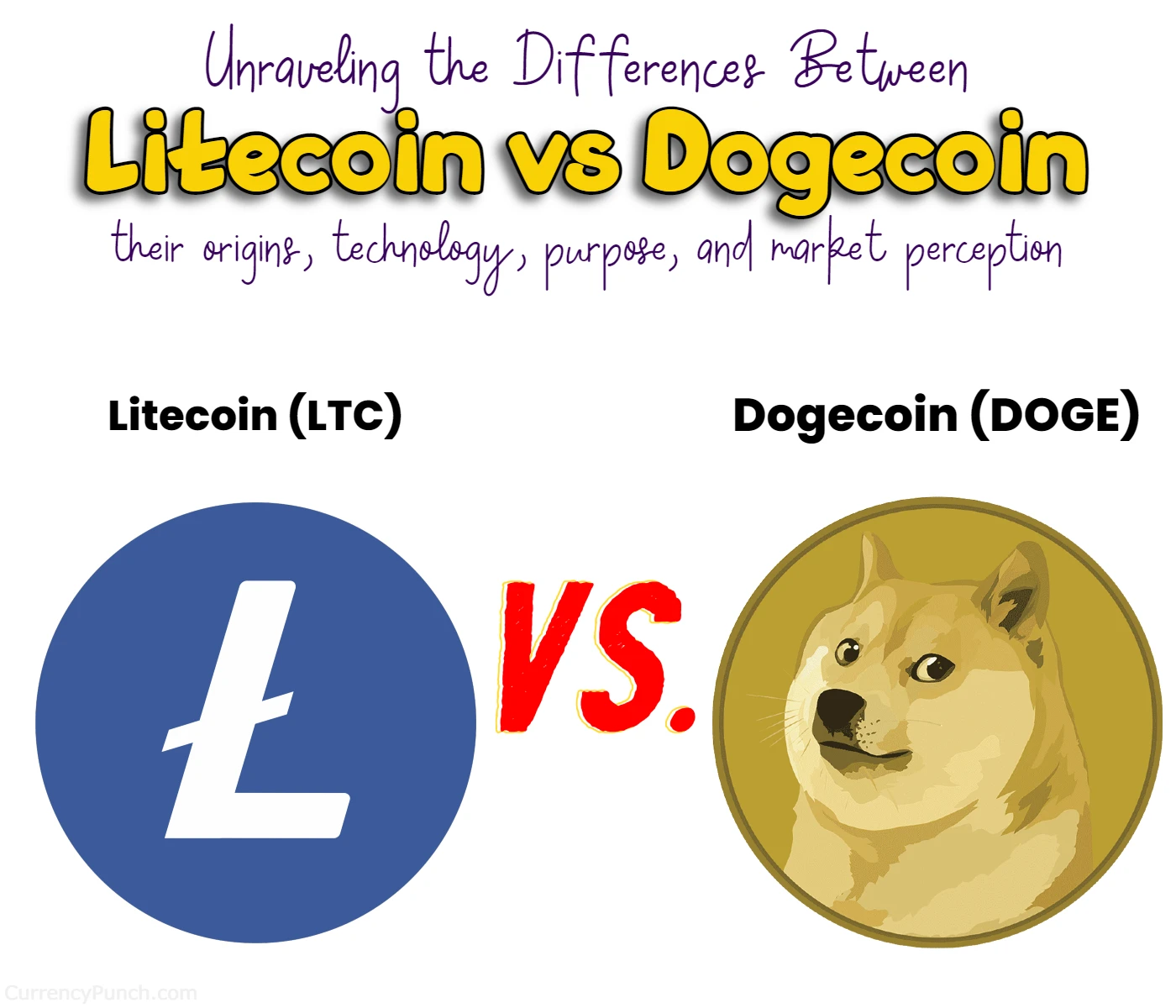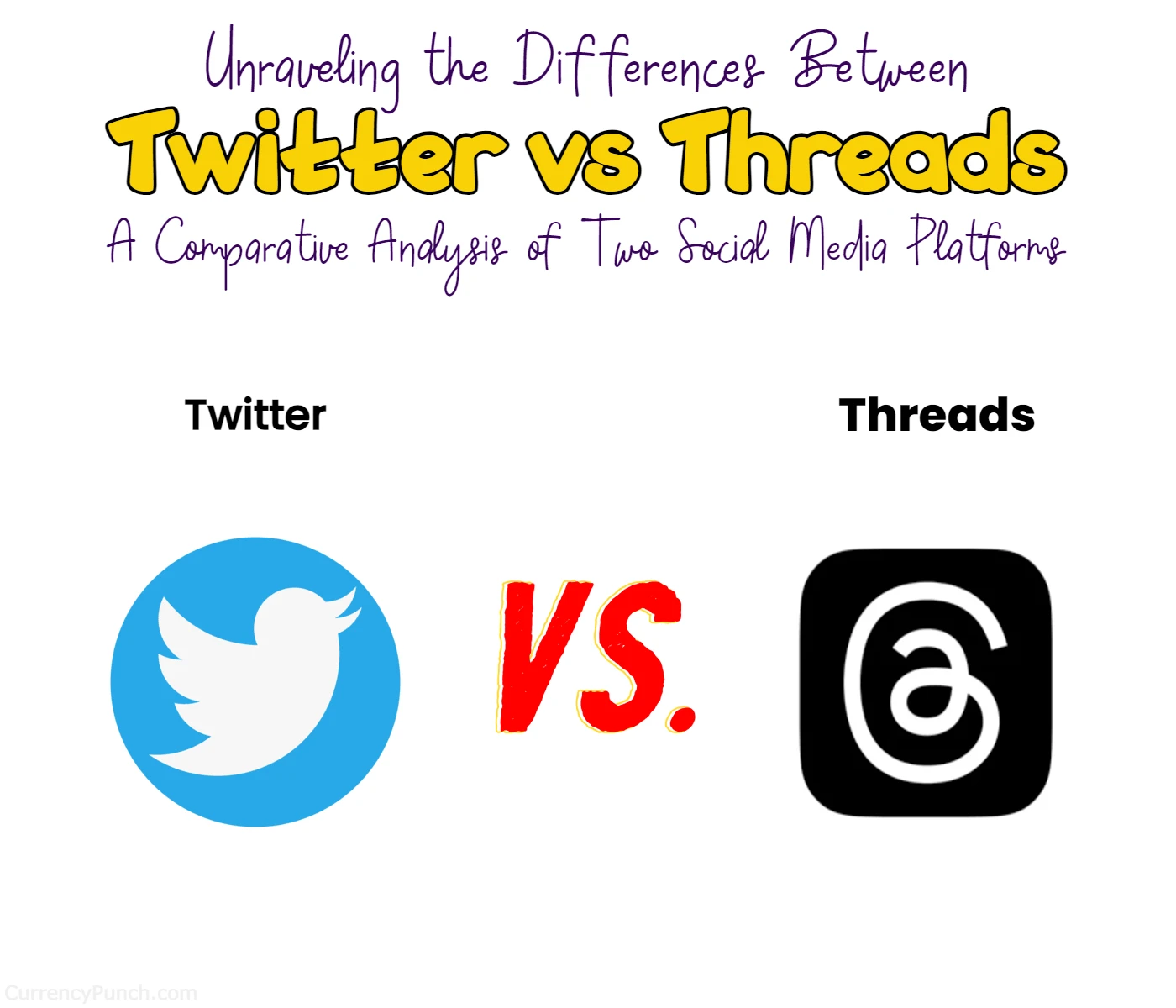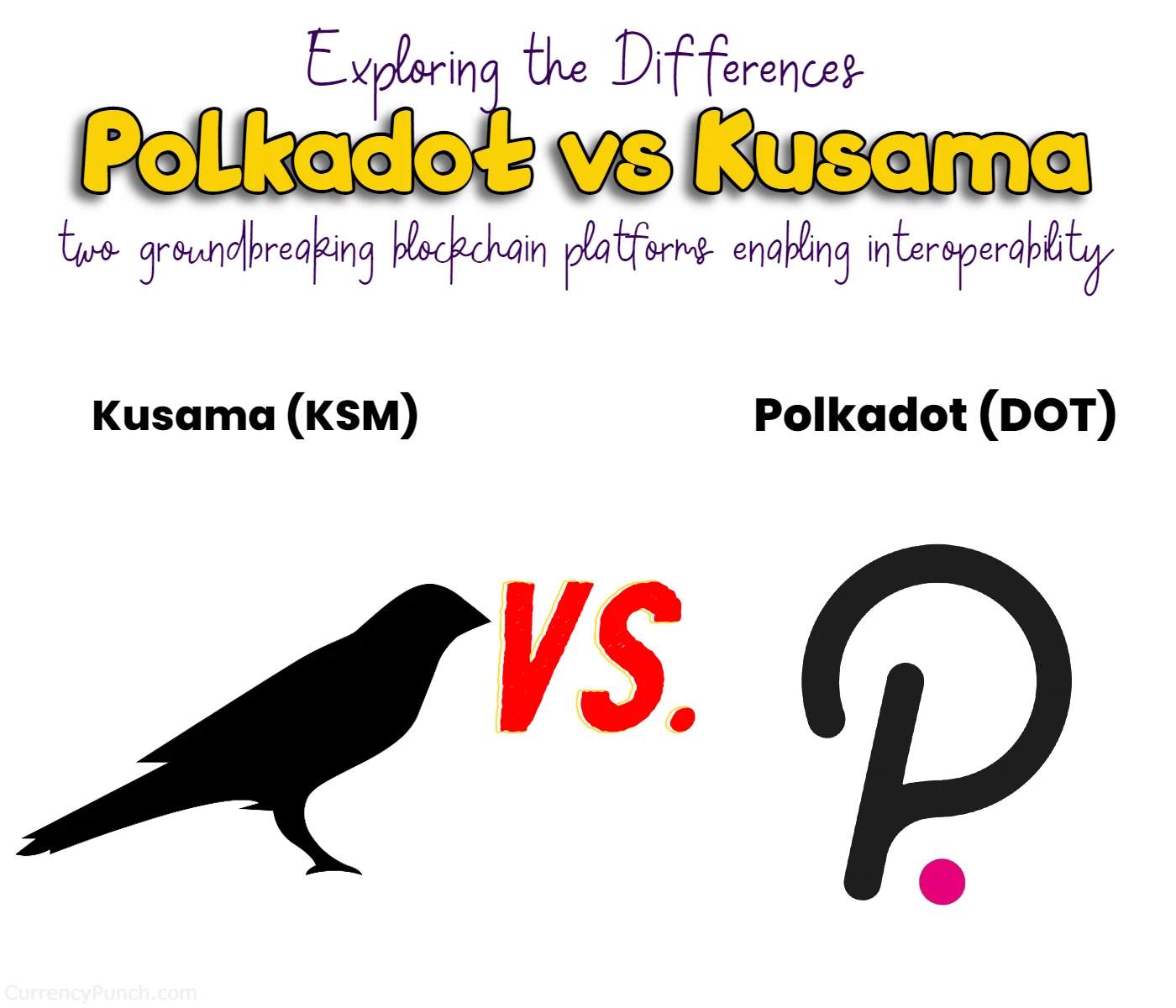Litecoin (LTC) vs Dogecoin (DOGE)
What is the difference between Dogecoin (DOGE) and Litecoin (LTC)?

Are you ready to dive into the world of cryptocurrencies and explore the intriguing differences between Litecoin (LTC) and Dogecoin (DOGE)? In this blog post, we’ll embark on an exciting journey to unravel the distinctions between these two popular digital assets. Whether you’re a seasoned crypto enthusiast or just beginning your crypto adventure, understanding the unique features and characteristics of LTC and DOGE will broaden your knowledge and help you make informed decisions in the ever-evolving crypto market.
We’ll start by exploring the fascinating origins of Litecoin and Dogecoin. Litecoin, created by former Google engineer Charlie Lee, emerged in 2011 as a “lite” version of Bitcoin. Lee’s vision was to address some of Bitcoin’s limitations by introducing faster transaction confirmation times and utilizing a different hashing algorithm. On the other paw, Dogecoin came into existence in 2013, inspired by an internet meme featuring the lovable Shiba Inu dog. Its founders, Billy Markus and Jackson Palmer, created Dogecoin as a playful and lighthearted cryptocurrency, never anticipating the immense popularity and impact it would eventually achieve.
Next, we’ll delve into the technological disparities between LTC and DOGE. While both coins are based on blockchain technology, they employ different consensus mechanisms and hashing algorithms. Litecoin utilizes a proof-of-work (PoW) algorithm called Scrypt, which aims to make mining more accessible to a broader range of participants. Dogecoin initially used Scrypt as well but later transitioned to a merged mining model with Litecoin, allowing miners to simultaneously mine both LTC and DOGE. Additionally, Litecoin boasts a faster block time of 2.5 minutes, making transactions quicker and more efficient, while Dogecoin impressively has a block time of just 1 minute, promoting lightning-fast transactions.
Here’s a quick chart highlighting the key differences between Litecoin (LTC) and Dogecoin (DOGE):
| Litecoin (LTC) | Dogecoin (DOGE) |
|---|---|
| Created in 2011 by | Created in 2013 by |
| Charlie Lee | Billy Markus and Jackson Palmer |
| Purpose: | Purpose: |
| – “Silver to Bitcoin’s gold” | – Fun-loving and meme-inspired |
| Technology: | Technology: |
| – Blockchain-based | – Blockchain-based |
| – Proof-of-Work (PoW) | – Proof-of-Work (PoW) |
| algorithm: Scrypt | algorithm: Scrypt |
| Block Time: | Block Time: |
| – 2.5 minutes | – 1 minute |
| Maximum Supply: | Maximum Supply: |
| – 84 million coins | – No maximum supply limit |
Differences Between Litecoin and Dogecoin
The Genesis Story: Origins and Founders
Every great cryptocurrency has a story behind its creation. Litecoin was born in 2011, when a former Google engineer named Charlie Lee decided to create a digital currency that addressed some of Bitcoin’s limitations. Lee aimed to create a “lite” version of Bitcoin by reducing block generation time and using a different hashing algorithm. Thus, Litecoin was brought to life.
On the other hand, Dogecoin emerged in late 2013, inspired by an internet meme featuring the iconic Shiba Inu dog. Billy Markus, an IBM software engineer, and Jackson Palmer, a software engineer at Adobe, teamed up to create Dogecoin as a lighthearted and fun cryptocurrency. Unlike Litecoin, Dogecoin was not designed to be a serious contender in the crypto market but rather as a satirical response to the growing number of altcoins.
The Technology: Similarities and Differences
- Blockchain Architecture: Both Litecoin and Dogecoin are based on blockchain technology, which ensures secure and transparent transactions. However, they employ different consensus mechanisms. Litecoin uses a proof-of-work (PoW) algorithm called Scrypt, whereas Dogecoin initially used Scrypt but later transitioned to a merged mining model with Litecoin. This means that both coins share the same mining process, allowing miners to simultaneously mine Litecoin and Dogecoin.
- Block Time and Supply: One of the primary differences between Litecoin and Dogecoin lies in their block generation time and total supply. Litecoin has a faster block time of 2.5 minutes, making transactions quicker and more efficient. Additionally, Litecoin has a maximum supply cap of 84 million coins, four times larger than Bitcoin’s supply. On the other hand, Dogecoin boasts an incredibly fast block time of just 1 minute, promoting speedy transactions. However, Dogecoin has no maximum supply limit, leading to a higher inflation rate.
- Hashing Algorithm: Another key distinction between Litecoin and Dogecoin is their hashing algorithms. Litecoin utilizes Scrypt, a memory-hard algorithm that aims to make mining more accessible to a broader range of participants. In contrast, Dogecoin initially used Scrypt but later transitioned to Auxiliary Proof-of-Work (AuxPoW), which allows Dogecoin miners to piggyback on Litecoin’s mining process, enhancing network security.
The Purpose: Serious vs Fun
Litecoin: The Silver to Bitcoin’s Gold: From its inception, Litecoin positioned itself as the “silver to Bitcoin’s gold.” Charlie Lee envisioned Litecoin as a complementary cryptocurrency that offered faster transaction confirmation times and a different hashing algorithm. Litecoin’s goal was to provide a viable alternative to Bitcoin, catering to users who valued speed and efficiency in their transactions. Over time, Litecoin has gained recognition as a reliable and established cryptocurrency, often seen as a “testnet” for Bitcoin due to its technological similarities.
Dogecoin: The Internet’s Favorite Meme: Unlike Litecoin’s serious undertones, Dogecoin was created as a lighthearted and meme-inspired cryptocurrency. Dogecoin’s primary purpose was to bring joy and humor to the crypto world while promoting charitable acts. Its community, known as the “Dogecoin Army” or “Shibes,” quickly grew and embraced the coin’s playful nature. Dogecoin gained popularity through various internet communities, especially Reddit, where users often tipped each other with Dogecoin as a form of appreciation. This lighthearted and fun-loving spirit propelled Dogecoin to become a beloved cryptocurrency among internet users, often associated with memes and viral moments.
Market Perception and Adoption
Litecoin’s Market Position: As one of the early altcoins, Litecoin has established itself as one of the most prominent cryptocurrencies in the market. It is widely accepted by various online and offline merchants, offering users an additional option for conducting transactions. Litecoin has also gained recognition as a valuable investment asset and is available on numerous cryptocurrency exchanges. Its position as a reliable and established cryptocurrency has attracted investors and traders alike.
Dogecoin’s Popularity Surge: Dogecoin’s journey has been quite remarkable. While initially created as a joke, it gained unexpected popularity and a massive following. The coin’s meteoric rise can be attributed to several factors, including endorsements from high-profile individuals, social media trends, and online communities rallying behind it. The surge in popularity led to increased adoption, with some businesses and online platforms accepting Dogecoin as a form of payment. However, it’s important to note that Dogecoin’s market perception is influenced to a significant extent by its meme-driven nature, which can lead to volatility and speculative trading.
Community and Social Impact
Litecoin’s Dedicated Community: Litecoin has a dedicated and supportive community of users and developers. Its community actively contributes to the development of the project, proposing improvements and implementing new features. The community also engages in educational initiatives, spreading awareness about cryptocurrencies and blockchain technology. Litecoin’s community-driven approach has helped it maintain a strong presence in the crypto space and fostered a sense of trust and reliability among its supporters.
Dogecoin’s Enthusiastic and Generous Shibes: Dogecoin’s community is known for its enthusiastic and generous nature. The community has participated in various charitable initiatives, raising funds for causes like disaster relief, community projects, and even sponsoring athletes and events. The Dogecoin community’s philanthropic endeavors have brought positive attention to the coin and highlighted the power of cryptocurrencies to make a real-world impact. While the community’s actions are often driven by fun and humor, they have demonstrated the potential of harnessing the collective power of a crypto community for social good.
Volatility and Investment Considerations
Litecoin’s Stability: Litecoin is generally considered to be less volatile compared to many other cryptocurrencies. Its established position, widespread adoption, and consistent development contribute to a sense of stability in the market. While Litecoin’s price may experience fluctuations along with the broader crypto market, it is often seen as a relatively safe investment option for those seeking a more established digital asset.
Dogecoin’s Rollercoaster Ride: Dogecoin’s price history is marked by significant volatility. Its meme-driven nature and the influence of social media trends can result in rapid price movements that may not necessarily align with traditional investment principles. Dogecoin’s price surges and subsequent corrections have attracted both fervent supporters and skeptics, making it a subject of intense debate within the crypto community. Investors considering Dogecoin should be prepared for its inherent volatility and understand the risks associated with investing in meme-driven assets.
Development and Future Roadmap
Litecoin’s Continued Development: Litecoin has an active development team that continues to work on improving the coin’s technology and enhancing its capabilities. The team focuses on maintaining compatibility with Bitcoin and implementing innovative features. Over the years, Litecoin has undergone upgrades such as Segregated Witness (SegWit) and the Lightning Network, which aim to improve scalability and transaction efficiency. Litecoin’s development roadmap includes ongoing improvements and collaborations with other projects in the crypto ecosystem, ensuring its relevance and competitiveness in the market.
Dogecoin’s Development Challenges: Dogecoin, due to its origins as a meme coin, has faced unique challenges in terms of development. While the coin has a dedicated community, the development efforts have been relatively limited compared to more established cryptocurrencies. Dogecoin’s codebase is based on Litecoin, which means it benefits from the ongoing development of the Litecoin project. However, the lack of a defined development roadmap specific to Dogecoin has raised questions about its long-term sustainability and ability to adapt to evolving market demands.
Regulatory and Institutional Adoption
Litecoin’s Compliance and Institutional Interest: As one of the early cryptocurrencies, Litecoin has garnered a level of regulatory compliance and institutional interest. Its reputation as a reliable and established digital asset has attracted the attention of traditional financial institutions and investment firms. Litecoin’s compliance with regulations and integration with financial infrastructure contribute to its potential for broader institutional adoption, offering users additional avenues for accessing and utilizing the coin.
Dogecoin’s Regulatory Landscape: Dogecoin, being a meme-driven cryptocurrency, has a different perception in the eyes of regulators and institutions. While it has gained popularity and a dedicated community, its association with internet memes and its lighthearted nature may lead to varying levels of acceptance among regulatory bodies and institutional investors. Dogecoin’s market volatility and speculative trading activity have also prompted caution from regulators, highlighting the need for a clearer regulatory framework to address meme coins and their impact on the market.
Conclusion: Different Paths, Unique Charms
In the vast world of cryptocurrencies, Litecoin and Dogecoin have carved out their own unique paths, capturing the hearts and minds of crypto enthusiasts in different ways. Litecoin’s serious and reliable nature positions it as a strong contender among cryptocurrencies, with its established technology, widespread adoption, and supportive community. On the other hand, Dogecoin’s meme-inspired origins and fun-loving community have brought joy and a sense of camaraderie to the crypto space, showcasing the power of a united community.
While Litecoin focuses on technological advancements and its role as a complementary cryptocurrency to Bitcoin, Dogecoin’s journey is intertwined with internet culture and social impact. Both coins have their strengths and weaknesses, and their future trajectories will depend on various factors such as market dynamics, regulatory developments, and community support.
As the tale of Litecoin and Dogecoin continues to unfold, it reminds us of the diverse and ever-evolving nature of the cryptocurrency landscape. Whether you lean towards the silver charm of Litecoin or the playful spirit of Dogecoin, the choice ultimately lies in your own preferences, investment goals, and beliefs in the potential of these digital assets. So, choose wisely, embark on your crypto adventures, and remember to enjoy the ride!
FAQs
Litecoin’s purpose is to serve as a digital currency for conducting fast and low-cost transactions. It aims to be a complementary asset to Bitcoin, providing a more efficient payment method. Dogecoin, on the other hand, has a more light-hearted purpose. It gained popularity as a tipping currency and is often used for microtransactions, online donations, and community-driven initiatives.
Both Litecoin and Dogecoin are blockchain-based cryptocurrencies. However, they differ in their hashing algorithms. Litecoin uses Scrypt, which aims to make mining more accessible. Dogecoin initially used Scrypt as well but later transitioned to a merged mining model with Litecoin, allowing miners to mine both LTC and DOGE simultaneously. Additionally, Litecoin has a faster block time of 2.5 minutes, while Dogecoin boasts an even faster block time of just 1 minute.
Litecoin is generally regarded as a more established and reliable cryptocurrency. It has gained recognition among merchants and investors, with a wider acceptance and integration into the financial ecosystem. Dogecoin, on the other hand, gained popularity through its meme-driven nature and a strong community following. It has a more volatile market perception due to its association with internet culture and the influence of social media trends.
Litecoin has a dedicated community of users and developers who actively contribute to its development and promote education about cryptocurrencies. Dogecoin’s community, known as the “Shibes,” is characterized by their fun-loving and generous nature. They have been involved in various charitable initiatives and community projects, showcasing the power of collective action.
Read More:



